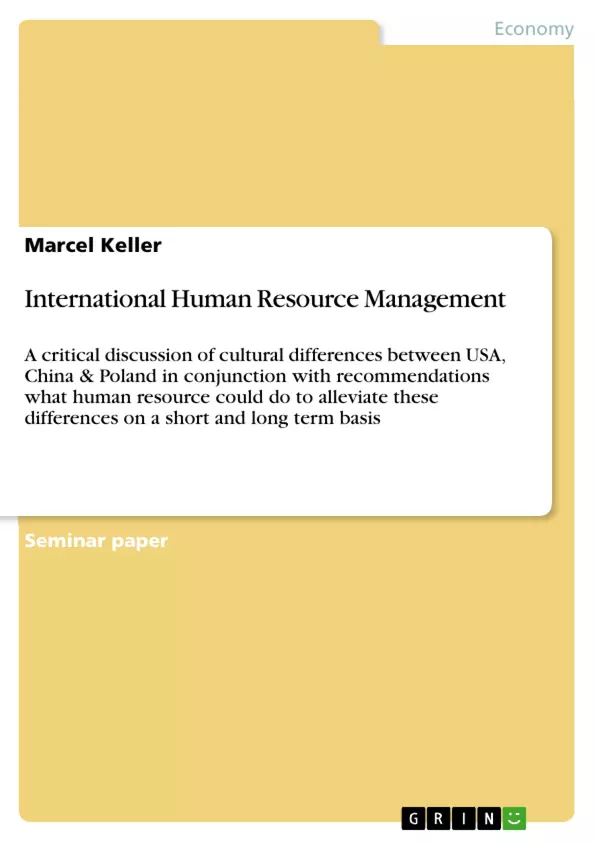It is a matter of fact that through increasing globalisation, multinational companies now face a wide range of issues related to cultural differences. This is especially true of a merger of three organisations from three different countries and continents, which would imply huge changes to an organisation and their cultural awareness.
Inhaltsverzeichnis (Table of Contents)
- Introduction
- The Countries of the New Organisation in a Concise Overview
- Detroit (USA)
- Guangdong (China)
- Katowice (Poland)
- Differences & Similarities between the Countries, likely Problems of the Merger & how to alleviate these Issues
- Language & Communication
- Potential Problems of Language & Communication
- Possible Recommendations to alleviate the Problems of Language & Communication
- Hofstede's Five Cultural Dimensions
- A Comparison between the different Countries within the New Organisation
- Possible Recommendations to alleviate the Problems of Cultural Differences
- Monochronic and Polychronic Business Cultures
- Potential Problems of Monochronic and Polychronic Business Cultures
- Possible Recommendations to alleviate the Problems of Monochronic and Polychronic Business Cultures
- Language & Communication
- Conclusion
Zielsetzung und Themenschwerpunkte (Objectives and Key Themes)
This report investigates the cultural differences between the USA, China and Poland within a new organization. It aims to discuss the potential challenges arising from these differences and develop recommendations for human resource management to alleviate them in the short and long term.
- The impact of cultural differences in a multinational merger
- The importance of communication and language in cross-cultural collaboration
- Applying Hofstede's Cultural Dimensions to understand and manage cultural differences
- The role of monochronic and polychronic business cultures in cross-cultural organizational structures
- Human resource management strategies for mitigating cultural differences.
Zusammenfassung der Kapitel (Chapter Summaries)
The introduction outlines the challenges posed by cultural differences in multinational organizations, particularly in the context of a merger between three companies from different countries. It introduces the specific merger involving a US-based automotive company, a Chinese organization, and a Polish production facility. The report establishes the organizational hierarchy and polycentric approach, where each subsidiary is managed by host-country nationals. The purpose of the report is to discuss cultural differences and provide recommendations for human resource management to mitigate these differences.
The second chapter provides a concise overview of the three countries involved in the merger. It highlights Detroit, USA as a hub for the automotive industry with a direct and informal communication style. The chapter then focuses on Guangdong, China, emphasizing the importance of respect and avoiding the use of the word "no" in communication. Lastly, Katowice, Poland is introduced as a region known for hard work, directness, and punctuality.
Schlüsselwörter (Keywords)
This report explores key concepts related to cross-cultural management, including cultural differences, multinational mergers, communication styles, Hofstede's cultural dimensions, monochronic and polychronic cultures, and human resource management strategies. It highlights the importance of intercultural sensitivity and effective management practices in navigating the complexities of global business operations.
- Quote paper
- B.Sc. Marcel Keller (Author), 2010, International Human Resource Management, Munich, GRIN Verlag, https://www.grin.com/document/160064



